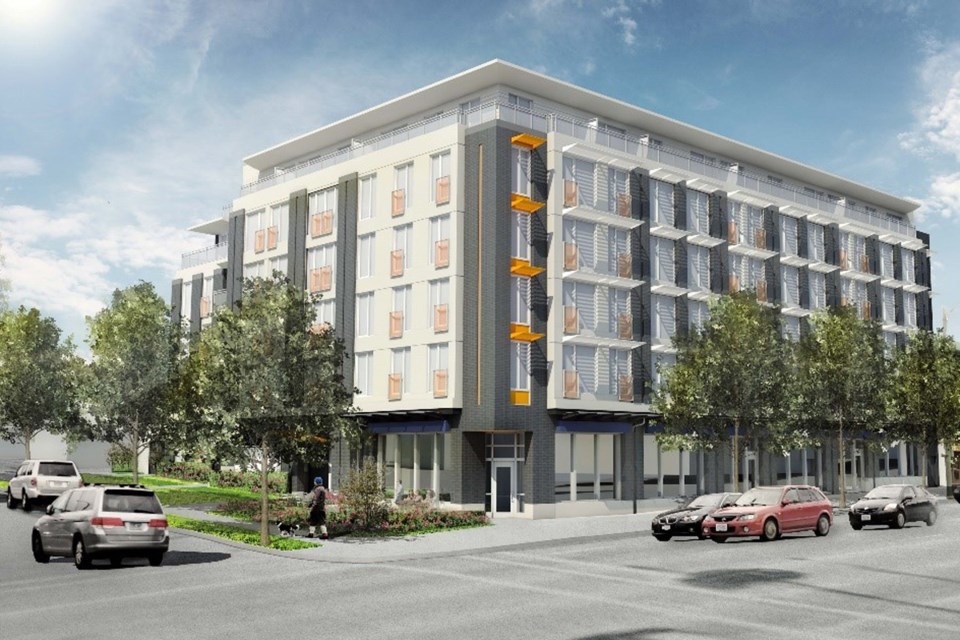The rental building under construction at the corner of East Hastings and Skeena Street looks similar to countless others being built around the city. But one detail, noted in small print on the promotional sign, calls attention to the difference: it aims to be designated a “Passive House,” a highly energy efficient building. It’s one of only a handful of buildings or houses in Vancouver that either have the designation or are targeting it. Once certified, the Heights — as it’s been dubbed by the developer — will be the largest building in Canada that’s met the Passive House standard.
Passive House is an international standard of energy efficiency. It focuses on reducing energy used to heat a home by creating an airtight structure, having high-quality windows and super-insulation, as well as good ventilation.
“Many passive houses are heated just with the air being provided to the suit or the building. You’d have a small heating element, smaller than the heating element in a hairdryer, for instance, that could gently heat the air because you have such low energy loss,” explained Chris Higgins, a green building planner for the City of Vancouver.
“Think about a thermos or a down coat — that’s similar to the approach a Passive House takes. It’s a super-insulated structure, it’s a super-insulated building, with very low heat loss, as opposed to traditional construction where you’re just trying to manage the heat loss [where] a large furnace [provides] the amount of heat required. In a Passive House you don’t have that large furnace.”
Eighth Avenue Development Group, Peak Construction and Cornerstore Architecture are involved in the rental-apartment project, which is expected to be completed in June of 2017.
It’s good news to Karen Tam Wu, program director of buildings and urban solutions at the Pembina Institute, a think tank dedicated to clean energy and reducing the impacts of fossil fuels, which organized a media tour of the Heights Tuesday morning.
“Basically, it’s a very tangible representation of the future of where Vancouver’s buildings, and where hopefully B.C. and Canada’s buildings, are going,” she said. “It’s important to realize that these types of buildings that are de-carbonized and low-energy — ultra-energy efficient, are the way of the future. They’re also representative of the local clean economy in action.”
Wu said, in B.C. alone, there are more than 23,000 jobs in the green building sector and more than 10,000 green homes and buildings.
She maintains those numbers will continue to grow now that Vancouver has a zero-emissions building plan and once B.C.’s recently announced climate leadership plan is implemented. A pan-Canadian framework is also expected to be announced at the beginning of December.
“This [Skeena Street building] is a chance to really see and hear about this way of building and the path forward to a de-carbonized future. And it’s great for the economy and local jobs,” she said.
“It’s not fancy technology that makes these buildings ultra-energy efficient. It’s very basic building science of having an air-tight building, with high-quality windows and super-insulation. This is how you reduce heat and energy loss and waste.”
In North America, the number of structures with Passive House designation has grown from 500 to 2,000 units — a quarter of that figure is accounted for in Vancouver. On Tuesday, Pembina Institute released a report called “Accelerating market transformation for high-performance building enclosures,” which tracks the growth of Passive House buildings, assesses their costs and benefits and addresses how policy can encourage their adoption.
Ed Kolic, president of Eighth Avenue Development Group, said the architect introduced him to the idea. Kolic said it makes for a much simpler building while meeting green building requirements. In the city of Vancouver, if you have to rezone a property, you have to meet the LEED Gold standard, which has a certain number of energy points that have to be achieved. That causes the mechanical system to become very complicated.
“The Passive House method of building is the equivalent of putting a down jacket on. Put a down jacket on, you’re warm. It’s all about the envelope that goes around the building. It blocks the thermal bridging. In other words, it’s so well insulated on the outside that it doesn’t allow any heat to escape,” he said. “If you’re not allowing much heat to escape, you’re not recreating much energy to heat your building any longer. It literally drops your energy bill by 85 per cent and that’s measurable. And because we've reduced the complexity of the mechanical system, it's now just a very simple building with electric baseboard heaters, which help reduce greenhouse gas emissions."
Kolic said he’s proud to be on the leading edge of this type of construction in B.C.
“It’s just starting to get some traction in North America. So to me, we’re promoting it. I’m an advocate of it,” he said.
Higgins said the Skeena project is important “because it’s an investor-led program and it really demonstrates that aside from city or civic goals, the business community is showing that this can be done. And when people are looking for a return on investment, there can be quite good alignment between environmental and financial performance and return on investment.”
He noted one of the advantages of building in Vancouver is that there is a local manufacturer of Passive House-certified windows — EuroLine Windows based in Delta, which helps control costs.
“For instance, a project building in Ottawa might import the windows from Europe and add cost and the delay built in there,” he said. “Projects that are trying to meet a construction schedule might be nervous about doing that. So that’s one real strength we have. Having a local manufacturer and having local supplies is important.”
noconnor@vancourier.com
@naoibh



